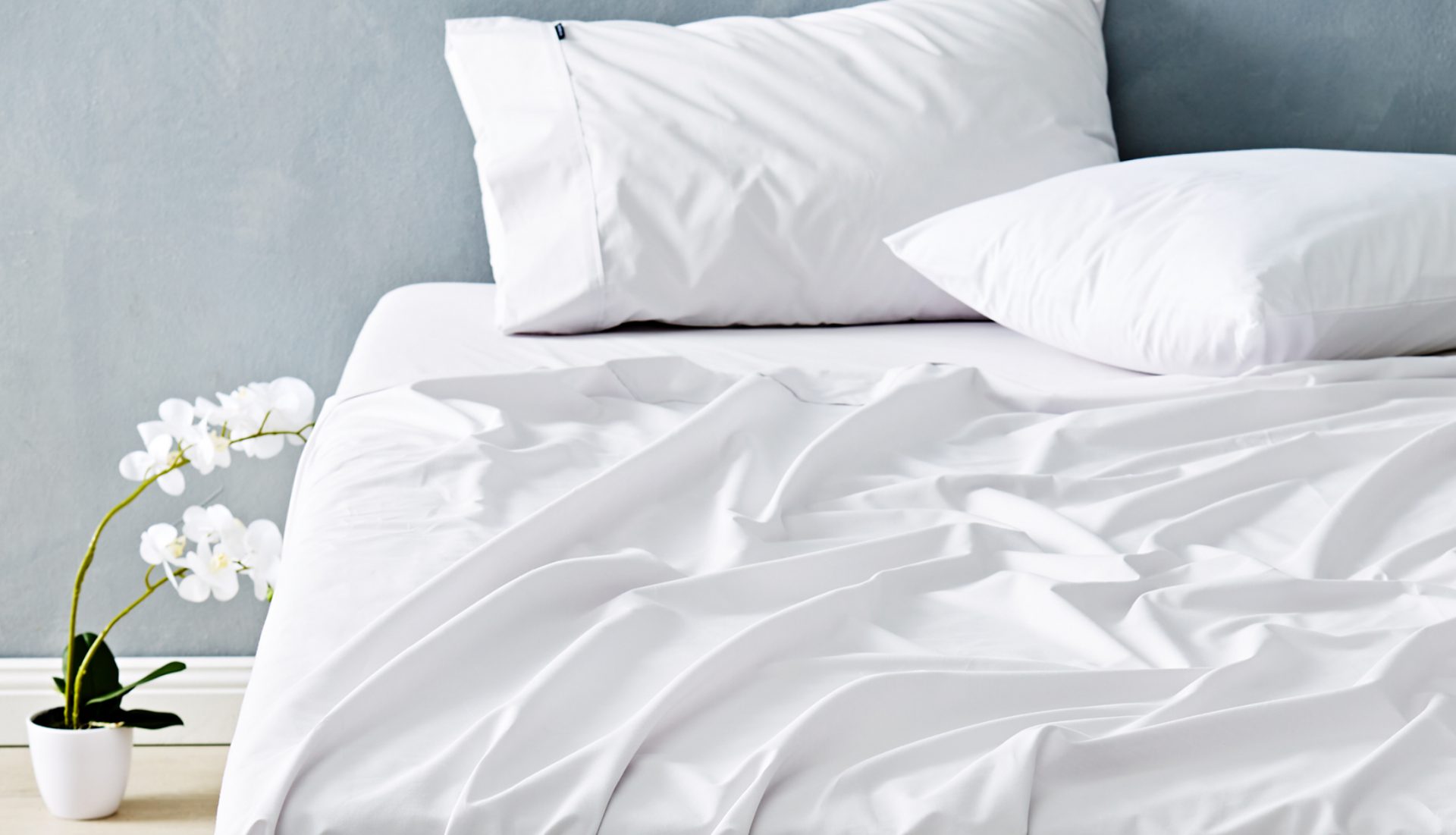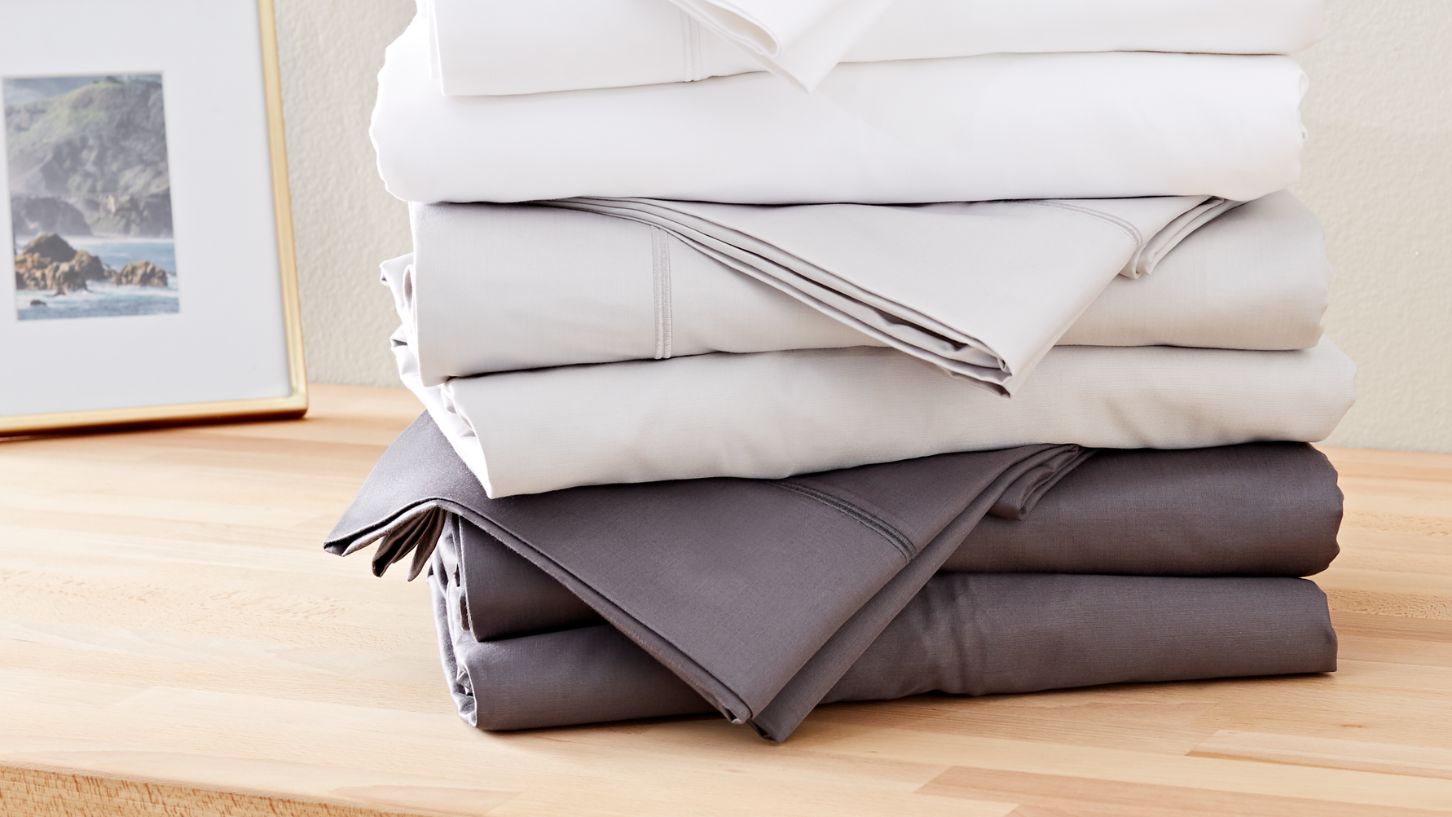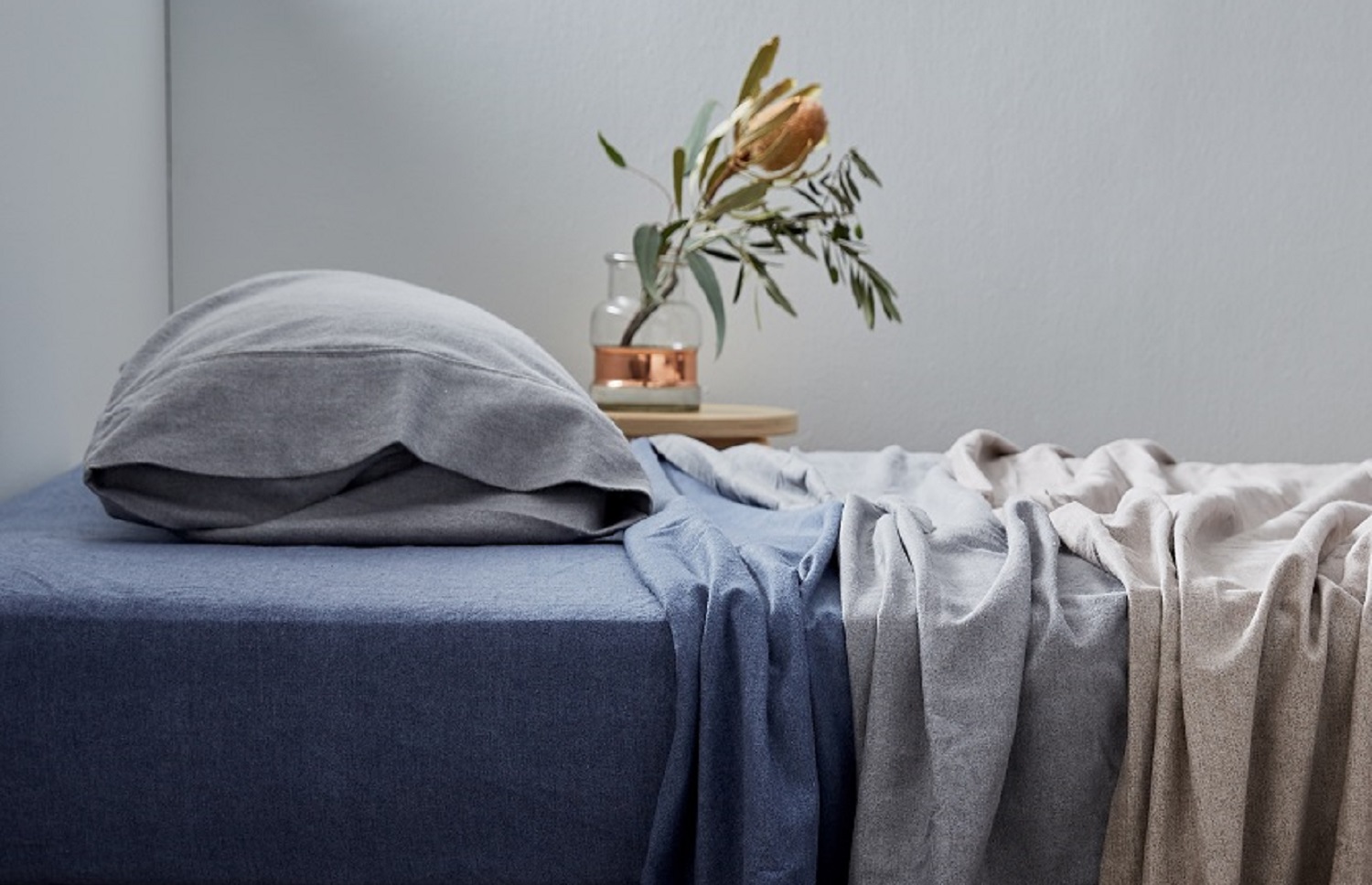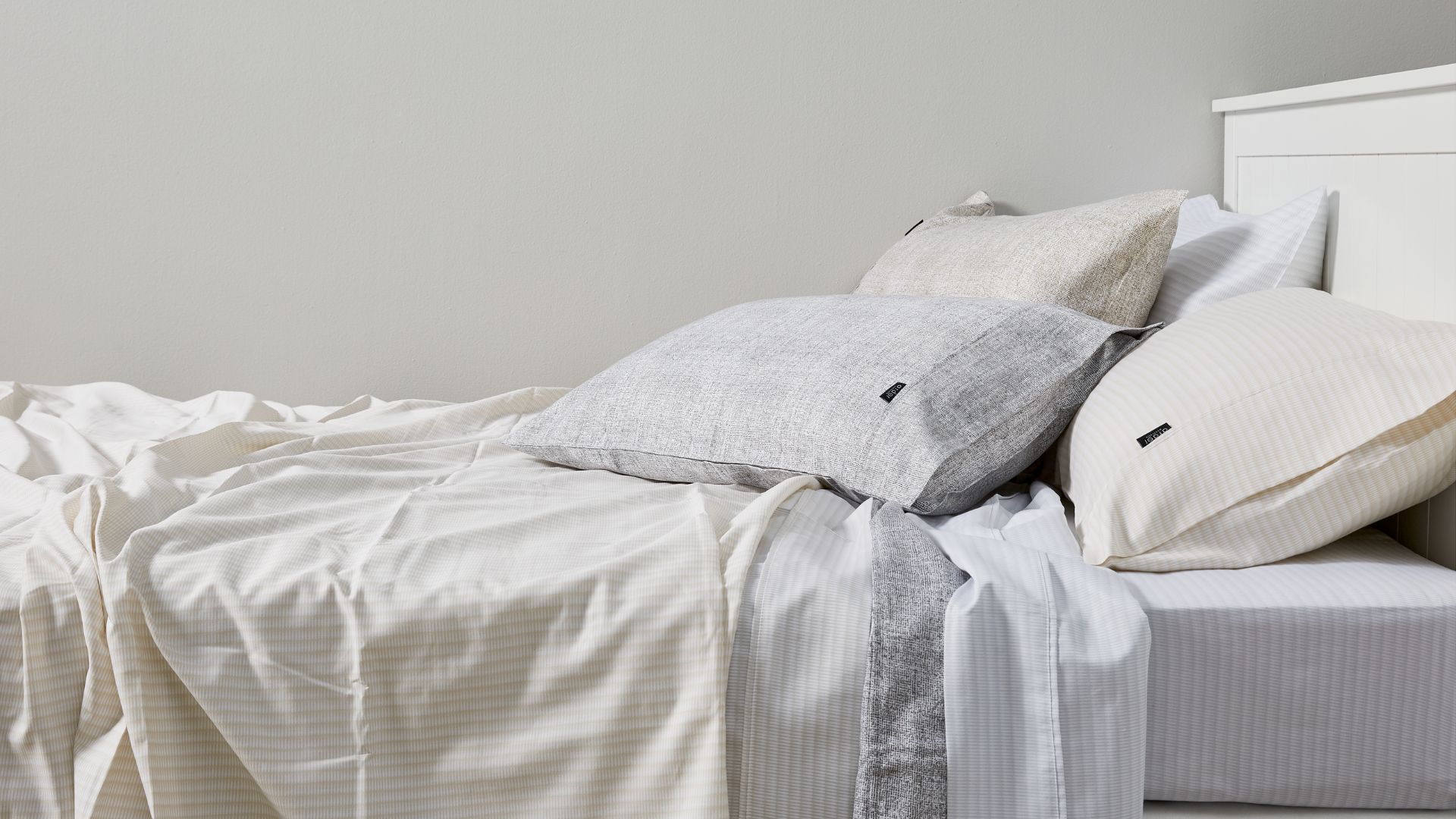| Your browser is not supported. | ||
|
Please browse our site using any of the following options:
| ||
Guide To Choosing The Best Bed Sheets

Soft, breathable fabrics, luxurious textures, a cosy sink-in mattress and sheets tucked in neatly - these are just some of the visuals that come to mind when you think of the perfect bed. If you've invested in a premium quality mattress for a good night's sleep, there's no reason to skimp on quality when it comes to bed sheets. After all, tossing and turning in a bed where the sheets feel itchy and stiff is hardly anyone's dream.
While mattress and bedding quality play a significant part in your overall comfort, don't overlook the importance of sheets for a good night's sleep. Offering a combination of warmth, insulation, and comfort, quality sheets are an important piece of the overarching bedding puzzle.
But here's the issue - there are too many options to pick and choose from. There's a lot to navigate - from brands, materials, and pricing. Let's face it, if anything, the process of buying the best bed sheets for your bed can feel stressful.
That's why we're breaking down everything you need to know - from materials, thread count, how often you should change bed sheets to all the small and big considerations to help you buy bed sheets with confidence.
Let's explore.
Quick Links
- What Is Included In A Sheet Set?
- How To Choose Bed Sheets For My Bed?
- What To Consider Before Buying Bed Sheets?
- Best Materials & Fabric for Bed Sheets
- Ultimate Bed Sheet Wash Guide: How To Care For Bed Sheets
- Bed Sheet Care: Commonly Asked Questions
- How To Store Clean Sheets
- The Best Sheets & Sheet Sets To Buy
What Is Included In A Sheet Set?
Let's start at the beginning and brush up on some basics. Typically, a sheet set will include
- One flat sheet
- One fitted sheet,
- A pair of pillowcases
How To Choose Bed Sheets For My Bed?
If you're planning to invest in quality bed linen, there's a lot to consider, and we'll go into that later in the guide. As a starting point, before you even start browsing, remember to measure the size of the sheet you want to buy. Picking the correct size will mean your sheets sit snugly on your mattress and prevent slippage while you sleep.

Fitted Sheet Size Guide At Harris Scarfe
Single fitted sheet | 91cm W x 190cm L x 40cm D |
King-single fitted sheet | 107cm W x 203cm L x 40cm D |
Double fitted sheet | 137cm W x 190cm L x 40cm D |
Queen fitted sheet | 152cm W x 203cm L x 40cm D |
King fitted sheet | 183cm W x 203cm L x 40cm D |
Super-king fitted sheet | 203cm W x 203cm L x 50cm D |
Flat Sheet Size Guide At Harris Scarfe
Single flat sheet | 199cm W x 279cm L |
King single flat sheet | 244cm W x 279cm L |
Double flat sheet | 244cm W x 266cm L |
Queen flat sheet | 259cm W x 279cm L |
King flat sheet | 289cm W x 279cm L |
Super-king flat sheet | 300cm W x 330cm L |
What To Consider Before Buying Bed Sheets?
Durability, thread count and stitching are the hallmarks of good-quality sheets. Since we spend a third of our day in bed, longevity is essential when choosing the best bed sheets. You'll want to evaluate materials and construction carefully, ensuring there are no loose fibres or pilling starting to occur.
For a full rundown on considerations to make when choosing bed sheets, take a look at our guide for how to choose the best fabric for bed sheets. This guide will help you discern the best types of sheets for different climates and establish the ideal thread count for different types of fabric.
Materials & Fabric
Materials are a significant consideration when buying sheets for your bed. Here are popular materials you could buy at Harris Scarfe. Below we explore the benefits of each type of best sheet materials:
Bamboo Cotton Sheets
Bamboo cotton is a soft, silky sustainable and eco-friendly fibre. Naturally hypoallergenic, bamboo is very breathable. This means it can help regulate your body temperature keeping you warm in winter and cool during summer.
Benefits:
- Softer than regular cotton
- Highly breathable and moisture-wicking
- Naturally hypoallergenic and anti-bacterial
Cotton Sheets
Cotton, a natural and breathable fibre, is perhaps the most commonly used in bed linen. It's ideal for sensitive skin and channels sweat from the skin, making it suitable for use throughout the year. It's also easy to wash and great for everyday use. Here are some of the most common types of cotton sheets available.
Benefits:
- Soft and comfortable
- Durable and long-lasting
- Breathable and moisture-absorbent
- Easy to care for and maintain
Egyptian Cotton Sheets
More robust than regular cotton and boasting better longevity, Egyptian cotton sheets are considered the epitome of luxury. These sheets have the smoothest touch and feel, courtesy of exceptionally long individual fibres.
Benefits:
- Exceptionally soft and luxurious
- Has longer fibres for greater durability
- Highly absorbent and breathable
- Resistant to pilling and fraying
Percale Sheets
These sheets are characterised by matte finishing and tight, flat cotton weaves that feel crisp. The fabric is lightweight, breathable, and great to use during summer.
Benefits:
- Crisp and cool feel
- Lightweight and breathable
- Strong and durable weave
- Easy to care for and wrinkle-resistant
Sateen Sheets
Cotton sateen sheets are distinctive for their lustrous sheen and silky smooth finish. With thicker yarn than percale, they feel soft to the touch and are cosy during winter. Ideal for cold sleepers throughout the year.
Benefits:
- Luxurious and silky smooth
- Has a subtle sheen and lustrous appearance
- Drapes beautifully and feels good against the skin
- Durable and resistant to fading
Tencel Sheets
Like cotton, Tencel is another natural fibre made from reconstituted wood cellulose. With their superior ability to absorb moisture, Tencel is great for warm sleepers. Tencel bed sheets are also less likely to wrinkle compared to many other fabrics.
Benefits:
- Made from sustainable wood pulp
- Highly breathable and moisture-wicking
- Soft and smooth to the touch
- Resistant to wrinkling and shrinking
Microfibre Sheets
Featuring tightly woven polyester microfibres, these sheets offer heaps of durability and strength. They're breathable, making them a comfortable choice for bed linen throughout the year. Microfibre sheets are usually wrinkle-resistant when washing or drying.
Benefits:
- Affordable and budget-friendly
- Extremely soft and comfortable
- Lightweight and easy to care for
- Hypoallergenic and resistant to dust mites
Flannelette Sheets
Composed of brushed cotton, flannelette offers a thicker and warmer sheet, making them ideal for cool sleepers and the colder months. The raised fibres of the sheet create a cosy, warm feel, making it an excellent investment during winter.
Benefits:
- Warm and cozy for cooler months
- Soft and comfortable against the skin
- Absorbs and retains moisture for added comfort
- Easy to care for and machine washable
What Material Blends Are Best For Sheets?
You can also choose from blended fabrics for your sheet. Polycotton, cotton-bamboo, nylon-polyester, and cotton-rayon are popular blended sheet types. Inexpensive, durable and wrinkle-resistant - these sheets are great for kids' bedding and those on a budget.
Top Things To Look Out For When Buying Bed Sheets
To make the best buying decision, here's a checklist of the things you need to keep in mind:
- Fibre (Fabric Type)
- Style
- Artistry
- Thoughtful design
Do You Need A Fitted And Flat Sheet?
A flat or the top sheet sits flat on top of the mattress. On the other hand, a fitted sheet is the bottom sheet that is identified by its elastic corners. It wraps snugly around the mattress, fitting securely. A top sheet helps keep the doona and quilt cover clean as it acts as a barrier between the sleeper and the cover, preventing sweat, oil, and dirt from the body from penetrating the bedding. During colder weather, using a flat sheet as a top sheet can provide additional warmth when added between the sleeper and a lighter-weight cover. Alternatively, in warmer weather, the top sheet can keep the sleeper cool by allowing airflow between the body and the comforter or duvet. However, many simply prefer the feeling of sleeping with only a quilt or comforter and feel that a top sheet is unnecessary. Choosing for yourself is a matter of preference. That's why we've decoded these terms and their relevance when buying sheets in our flat vs fitted sheet guide.

How Will Good Sheets Help Me Sleep Better?
While it's essential to do your due diligence on fibres and materials, having clarity on your personal preferences is equally crucial. The first step is figuring out the texture of the fabric you like, and how cool or hot you sleep.
For instance, percale bed linen could be a great solution if you love the feeling of crisp, hotel-quality sheets. Similarly, if you're a hot sleeper, you might want to consider breathable and natural fabrics like cotton or linen. If luxury is your goal, perhaps silk sheets are your go-to. Flannelette is one of your best bed sheet options for those who get cold and need to stay warm throughout the night. So, yes, a good sheet can undoubtedly help you sleep better.
Ultimate Bed Sheet Wash Guide: How To Care For Bed Sheets
While choosing the best sheets for your bed is key, bedding hygiene is equally critical for your health and sleep quality. When you don't change and wash your sheets regularly, you risk opening yourself up to allergies, skin breakouts and so much more. Discover the importance of regular cleaning here, and find out how often you should wash your sheets, along with tips and tricks on looking after your bed linen.
Bed Sheet Care: Commonly Asked Questions
Should you wash new sheets before use?
We highly recommend washing new sheets before their first use. There are a number of reasons for this. Sheets could be exposed to dust, chemicals, and contaminants during transportation and cause discomfort and skin irritation.
How to brighten white sheets?
A great hack to wash white sheets and brighten them is by adding a quarter cup of lemon juice into the wash water. It's a natural yet effective alternative to harsh bleaches or any other brightening chemicals.
How to keep my sheets clean between washes?
We recommend weekly washes for your bedsheets. In between that time, here are a few ways to keep your sheet looking and feeling clean.
- Take a shower before bed
- Avoid drinking or eating in bed
- Remove makeup before sleeping
- Wash your feet or remove sock debris before getting into bed
Can I tumble-dry linen sheets?
Dry linen sheets naturally in a shady spot. We don't recommend using a dryer, however, if you must use it, always use a low setting. Avoid dry cleaning as this can weaken fibres.
Can I put flannelette sheets in the dryer?
Your flannelette sheet will last longer if left to dry naturally. So, avoid the dryer if possible. Alternatively, use the dryer on its lowest temperature setting to avoid shrinkage.
How often should you wash your sheets?
If you're wondering, do I need to wash my sheets often? The answer is a resounding YES! We recommend washing your sheets once every week to improve your bedding hygiene and sleep quality. But, if you're pressed for time, wash them once every two weeks at a minimum. During the summer months, stick to a more frequent washing regime.
We spend a third of our lives in bed. On average that's 50+ hours weekly of sweat, gunk, body oil, and dead skin cells collecting on our sheets. Then there's the added concern of dust mites that thrive on dead skin cells. You may also need to wash your sheets frequently if:
- Your pet sleeps with you
- You're allergic to dust or have asthma
- You're a hot sleeper and sweat in bed
- You frequently eat in bed
- You have sensitive skin
What happens when you don't change your sheets?
There's a very high chance you'll open yourself up to bacteria, pollen, fungi, and animal hair. And while sweat and skin cells are not enough to make you sick - it could trigger eczema in people with contact dermatitis.
Dust mites live off dead skin cells and multiply easily, often worsening allergies and asthma symptoms. These tiny microscopic creatures could also wreak havoc causing skin rashes and other irritations. So, washing your sheets is critical
How to wash bed sheets the right way
We're offering you a step-by-step guide to help you wash your sheets like a pro.
How to load the washing machine
- Don't jam the washing machine with too many sheets. Sheets need space to circulate in the water for a thorough clean-up.
- Wash your sheets separately from towels and other clothing. This will prevent damage from zippers or items getting tangled and balled up.
What settings should I use to wash the sheets?
- Start by checking the care labels, to see if there are any specific instructions to follow.
- Select the water temperature the label suggests. You should wash on the hottest setting recommended as the hotter the water, the more bacteria is removed.
- Pick a cycle depending on how soiled the sheets are. Remember: Overwashing will wear out the fabric faster. We recommend a normal or regular cycle unless the bedsheets are unusually dirty.
Tips to wash your sheets
- Always use a gentle detergent for cotton and cotton-polyester-blend sheets.
- Fabrics like linen and silk could require a different detergent, so don't forget to check the product's care label.
- White and light-coloured cotton sheets are great to wash at any temperature.
- Reduce fading and increase the longevity of your dark-coloured sheets by washing and rinsing in cool water.
- Always remember to separate by colour. Just like clothing, dark colours can bleed into lighter sheets.
- Pre-treat the stains on your sheets before popping them into the washer. This is a good way to ensure small stains are easily removed.
How to dry sheets correctly
Can you put sheets in the dryer? Yes, you absolutely can. Machine drying is a great way to create softer-feeling sheets. Here are a few tips to consider:
- Your bedsheets will come out of your washing machine twisted up. Remember to untwist them before transferring them into a dryer.
- Use one sheet set at a time. It's the best way to get them to tumble freely.
- Follow the suggested dryer temperature on the sheet's care label.
- Take care to use a low-heat setting, as over-drying and higher temperatures could cause wrinkling, shrinking, and weakening fibres.
- Once the sheets are only slightly damp to the touch, take them out of the dryer, and hand-press them on a flat surface to prevent further wrinkles.
Pro tip: Dry sheets with the tennis ball method
To ensure your sheets dry evenly in the dryer, give the tennis ball method a go! As the dryer spins, the tennis balls create gaps between the sheets. This prevents them from bundling up and hot air circulates better, in turn drying your sheets faster. Here's a quick step-by-step to help you get started:
- Load the sheets into the dryer
- Throw in two or three brand new tennis balls
- Run the dryer cycle
A note on line-drying your sheets
Line-drying is easily one of the better ways to improve your bedding's longevity. Take care, however, to ensure they're not exposed to direct sunlight. You'll enjoy a nice fresh scent, plus the process of line-drying saves a lot of energy. If you've line-dried your sheets, you'll notice they can feel rough to touch. In that case, simply toss it into a dryer for a few minutes to help soften the fabric.
Mistakes to avoid when washing & drying bed sheets
It's easy to fall into the trap of making these common mistakes when washing and drying your sheets. So what can you do to avoid them? Read on.
Mistake 1: Overload the washing machine
It's always tempting to run everything in one load, but take care not to overload the washer with more than it can take. There won't be enough room for your sheets to circulate, and this will affect the soaking and rinsing process.
Mistake 2: Making detergent mistakes
Whether it's too much detergent or using a harsh variety - both are capable of damaging your sheets. If you've splurged on luxurious linens or ultra-soft Egyptian cotton sheets, consider using a gentle detergent for longevity.
Mistake 3: Not reading the care instructions
This sounds overly simple, and yet, is often overlooked. You'll see how some sheets will need a gentle cycle wash while line-drying in a shady corner is recommended to help preserve a sheet's colours. Take a few minutes to read the label and save yourself the frustration of a ruined bedsheet, post-wash.
How to store clean sheets
Always remember to store matching sheets together. This will help you save time when making up the bed. We're sharing a few tips on organising and storing your clean bedsheets.
- Always choose a dry and dark space with good airflow to store your sheets and other bedding. Humidity will promote the growth of mould and mildew and make your sheets musty and smelly.
- Fold your sheets neatly, but avoid packing them together too tightly. Air circulation is key to keeping them smelling fresh.
- Fold sheets and place them inside their pillowcase. This makes it easy to sort and identify them from other bedding.
- Baking soda in an open container can work as an excellent odour neutraliser in your linen cupboard.
Delve deeper into some expert tips on storing linen with our guide to storing bed linen creatively.

Shop The Best Sheets & Sheet Sets To Buy At Harris Scarfe
The best sheets for your bed are the ones that fit your needs and budget. Harris Scarfe offers a wide range of materials like cotton, flannelette, Tencel, Egyptian cotton and more across a wide range of budget options to suit every need and sleeping type. Available as sheet sets and individual sheets, you have heaps of flexibility and choice. Discover our extensive bedroom range online and in-store.